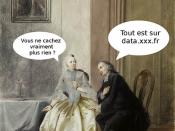When reading a work of fiction, one has to be aware of different writing styles that will clue you into the information that the author wants one to pick up on. In the works, Molière's "Tartuffe" and Voltaire's "Candide" the themes of appearance vs. reality can be found. I will be discussing this theme which is both obvious and subtle depending on the author. I will be discussing the theme of appearance vs. reality.
In "Tartuffe", the character "Tartuffe" is touted as a holy zealous man that is supposed to be pious. Tartuffe is actually a master con-artist who gains entrée into the household of Orgon by portraying himself as a holy man. Throughout the play Tartuffe first gains permission to marry Orgon's daughter Marianne, then he proceeds to try and seduce her mother and Orgon's wife Elmire. This is one of the most obvious scenes in which one can see Tartuffe's façade being challenged.
Elmire: 'Your declaration is most gallant, Sir, But don't you think it's out of character? You'd have done better to restrain your passion and think before you spoke in such a fashion. It ill becomes a pious man like you... '
Tartuffe: 'I may be pious, but I am human too: With your celestial charms before his eyes, a man has not the power to be wise. I know such words sound strangely coming from me, but I'm no angel, nor was meant to be' (Moliére Act III Sc IV).
Tartuffe is trying to gain the affection of Elmire despite the fact that he is betrothed to Marianne. He makes another pass at Elmire again in Act Four. In this scene, Tartuffe is trying to convince Elmire that they can have an affair. Tartuffe uses language and logic that betray that he is not in...


